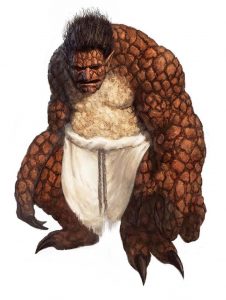
TV to Tabletop is a series where we take ideas from popular fantasy TV and movies and translate them to D&D terms. Use them in your own game as is, rename them to hide your sources, or get inspiration for your own new ideas!
In the Netflix series, Wednesday, the environs around Wednesday Addams’s prep school are stalked by an unknown monster. The creature leaves little trace, other than the mangled remains of its victims. What is this creature? Where does it come from? More importantly, how can you put one into your game?
These rules allow you to give a Humanoid an evil alter ego, or an alter evil, if you will. It could be a surprising, monstrous form that a doppelganger uses when discovered, an alchemical experiment gone wrong, or a hidden race of creatures living among normal humanoids.
Alter Evil
The proportions of this hairy, muscular humanoid are grotesque. Its face twists savagely with unconcealed rage.
This creature is the product of repressed anger. The base element is a humanoid subjected to repeated abuse, humiliation, or oppression who cannot or will not express its feelings, locking them away in their psyche.
Once this unfortunate soul is secured, bringing forth the monster requires a catalyst such as an alchemical solution, a curse, a ritual, or some dark god or fiendish entity granting the humanoid’s secret wish for vengeance. This triggers the first transformation, changing the humanoid into a larger, more monstrous version of itself—an evil alternate. The monstrous form is free of moral constraints, able to act on its feelings as violently as possible.
Afterward, they may change in instances of duress, or their alter evil may emerge while they sleep, to stalk the night and indulge in violent excesses.
Post-transformation, a humanoid might not remember its actions. Others remember, but refuse to take responsibility for their actions in that form, pretending that it is a separate creature. Still others embrace the change, reveling in their claim to such power and using it to punish any perceived sleight against them, becoming as morally corrupt as their altered selves.
A creature’s altered form bears little resemblance to its normal form, though it may still bear characteristics of its race. Alter evils vary in appearance by individual, but most have bowed legs and a hunched posture that belies their true height. Their arms are long and end in wicked claws that drag the ground when they walk. Their eyes are typically large and protruding and adapted to the darkness of night. The alter evil is significantly larger than its normal humanoid form. A Small-sized humanoid becomes a Medium alter evil, where a Medium-sized humanoid is Large when transformed. If an alter evil is killed, its body reverts to its normal humanoid form.
Hyde. Alter evils are often called “Hydes,” a reference to the name taken by the first recorded alter evil. Tales of the first Hyde’s murderous exploits are infamous enough to ascribe his name to all such creatures.
Secret Master. Sometimes an alter evil is awakened by an individual: a demon, a wizard, or some creature with great maleficent power. In such instances, the humanoid is beholden to this individual, following their commands and using their alter evil to assist their new master.
Vengeful Avatars. The alter evil is the humanoid’s way of reacting to people and events that cause negative emotional responses. Typically the humanoid weathers an uncomfortable encounter or event, perhaps retreating in the face of hostile behavior or giving in to demands. Then, later, in alter evil form, the humanoid catches up to its tormentors and unleashes terrible revenge.
Notes: All statistics listed for an alter evil represent the humanoid’s transformed state. For its normal form, use an appropriate creature or NPC stat block. The stat block below is meant for a transformation from a Humanoid of Medium size. For the alter evil of a Small Humanoid, reduce the Hit Dice to d8s and reduce damage dealt by attacks by 1 die (e.g., 2d6 becomes 1d6). Reduce the Challenge Rating to 3.
Alter Evil
Large Humanoid (Shapechanger), Neutral Evil
Armor Class 14 (natural armor)
Hit Points 85 (10d10 + 30)
Speed 40 ft., climb 20 ft.
| STR | DEX | CON | INT | WIS | CHA |
| 19 (+4) | 14 (+2) | 17 (+3) | 10 (+0) | 11 (+0) | 12 (+1) |
Saving Throws Str +6, Con +5
Skills Athletics +6, Intimidation +5, Perception +2, Stealth +4
Condition Immunities charmed, frightened
Senses darkvision 60 ft., passive Perception 12
Languages all languages normally spoken by its base race
Challenge 4 (1,100 XP) Proficiency Bonus +2
Relentless (Recharges after a Short or Long Rest). If the alter evil takes 15 damage or less that would reduce it to 0 hit points, it is reduced to 1 hit point instead.
ACTIONS
Multiattack. The alter evil makes two melee attacks.
Bite. Melee Weapon Attack: +6 to hit, reach 5 ft., one target. Hit: 9 (2d4 + 4) piercing damage.
Claw. Melee Weapon Attack: +6 to hit, reach 5 ft., one target. Hit: 13 (2d8 + 4) slashing damage.
REACTIONS
Rushing Rage. If the alter evil takes damage from a ranged attack, it can use its reaction to move up to its speed toward the attacker, making one Claw attack if the target is within reach at the end of its movement.
Want more monsters to enrage and delight your players? Tome of Beasts 3 has you covered!
Get over 400 brand-new monsters for your 5E DnD or Project Black Flag playtest games!
